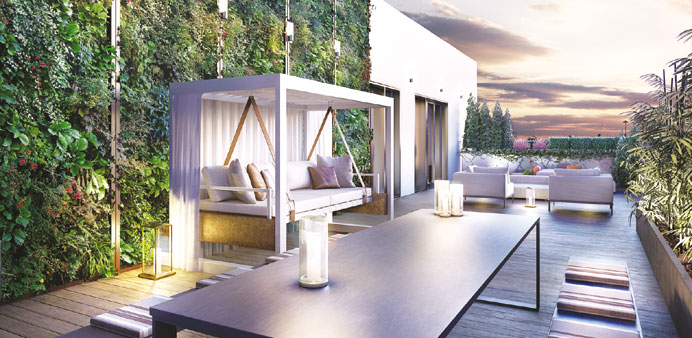The Chilterns has a ‘basic canvas’ of two different moods, the first contemporary and the second classic.
By Denise Marray/Gulf Times Correspondent/London
Qatari buyers have snapped up apartments in an exclusive new London development created by Galliard Homes and Frogmore, which is due for completion in 2015.
Located in the stylish Marylebone area, with easy access to the West End and The City, The Chilterns (named after its Chiltern Street address) comprises 44 two- and three-bedroom apartments and one six-bedroom penthouse.
The facade of the building, with textures and colours designed to emulate a series of records on a shelf, takes its inspiration from The Beatles ‘Apple Boutique’, which Paul McCartney described as “A beautiful place where beautiful people could buy beautiful things.” It is said that McCartney wrote the Beatles’ hit ‘Yesterday’ in an attic flat in Marylebone. The area boasts quite a list of famous former residents including the poet Byron, Charles Dickens, rock legend Jimi Hendrix, and of course, the world famous detective, Sherlock Holmes, whose residence was on Baker Street.
The area combines a traditional village atmosphere with designer boutiques and top restaurants. The Chilterns is conveniently located within easy access to Mayfair and Regent’s Park.
A big draw for Qatari buyers who have invested in a Chilterns’ apartment, is the inspiring interior design, which bears the coveted signature of architect, designer and curator, Rabih Hage.
Lebanese by birth, Hage spent his childhood in Beirut where he soaked up his Arab heritage. When his family fled the war-torn country, he moved to France and trained as an architect at the Ecole des Beaux Arts, Paris. He has designed many schemes for private homes, hotels and numerous award-winning commercial and corporate concepts in Europe, the Middle East and the US. The French government bestowed on him the honour of Chevalier de l’Ordre National du Merite, in recognition for his great contribution to the international design world.
Since establishing his studio in London in 2001, Hage has shifted his focus to interiors, renovation and new build architecture projects.
Hage explained that the Chilterns has a ‘basic canvas’ of two different moods, the first contemporary and the second classic. The classic style includes traditional elements of decoration such as chevron flooring and cornicing. Clients can then choose between six different schemes: Timeless, The Collector, The Voyager, The Minimalist, Neo-heritage and Connoisseur. Each scheme is carefully designed to appeal to the particular tastes of certain types of buyers.
Hage explained that the scheme he has called The Voyager particularly appeals to buyers from Qatar. Typically, this person is very well travelled and has collected artefacts and objects from many different countries and cultures. There would be a desire to have an interior that reflected this cultured and eclectic taste. So The Voyager interior could include, for example, Chinese vases, Persian rugs, Indian sideboards with elements of European art deco style and a hint of contemporary art.
The other style which is sought-after by Qatari buyers is very contemporary, reflecting the tastes of younger generation who, as Hage said, “are extremely well-educated aesthetically in contemporary art and design.” He noted: “Qatar, with its many contemporary galleries, is leading in this field — there is a younger generation who are very fashionable and influential in the art world and we should not ignore this trend.”
Hage believes that the days when Gulf visitors to Europe would pay lip service to the recommendations of European self-proclaimed ‘arbiters of taste’ are over. He said that it is a part of Arab culture to be polite to the host and this has meant that people have been reserved in expressing their real opinions. However, today there was an understanding that it is better to express an opinion not only for personal reasons but also to guide the vendor in developing a better understanding of requirements.
“Gulf customers are turning from followers to leaders in taste. They have for a long time been underestimated with regard to the quality of their eye and discernment,” he said.
“They have endured being treated by a lot of developers as if they are ‘barrels of money’ rather than sophisticated consumers who want products that have substance and authenticity — not just something encased in a glossy package and relentlessly flogged,” he added.
Hage would like to see buildings in the Gulf drawing more on the elements that reflect the culture and identity of the region. He commented that the trend of ‘copy and pasting’ western style shopping malls into the region was a negation of the traditional culture that centred around the Souq. He said that the design of the Souq was suited to the culture and climate. It encouraged discourse and commerce in a space that was comfortable, hospitable and protected from the harsh sun.
Instead of building another glass-walled tower, or as he termed it ‘massive energy consuming machine’ which costs a fortune to cool, why not build using traditional designs better suited to the climate?
He would also love, he said, to design a hotel in Qatar to reflect the unique culture and hospitality of the country.
Meantime, however, he is engaged in ensuring that the wishes of his Qatari clients and all those who have invested in The Chilterns are fully realised. He expects his designs to stand the test of time — always allowing for the home to mature and evolve over the years while retaining the essential design ingredients that set the home apart and first endeared it to the client.

